
May 05 , 2021.
Italy , Stromboli :
Weekly bulletin from April 26, 2021 to May 02, 2021 (issue date May 04, 2021)
SUMMARY OF THE STATE OF ACTIVITY
In the light of surveillance data, it is highlighted:
1) VOLCANOLOGICAL OBSERVATIONS: Normal explosive volcanic activity of Strombolian type accompanied by sometimes intense projection activity in the N2 zone. The total frequency of events showed values between the average levels (13-15 events / h). The intensity of the explosions varied from low to medium-high in the North crater area and medium-high in the Center-South area.
2) SEISMOLOGY: The monitored seismological parameters do not show significant variations.
3) DEFORMATIONS: A low deformation transient is noted on Sunday, May 2, 2021.
4) GEOCHEMISTRY: SO2 flow at medium level
The C / S ratio in the plume is at average values
The isotopic ratio of Helium shows average values.
5) SATELLITE OBSERVATIONS: The thermal activity in the summit area is at a medium-low level.
VOLCANOLOGICAL OBSERVATIONS
In the period under observation, the eruptive activity of Stromboli was characterized by the analysis of the images recorded by the surveillance cameras INGV-OE located at an altitude of 190 m, Punta Corvi and an altitude of 400 m.
Description of the morphology and explosive activity of the crater area following the inspection of April 26, 2021 by I.N.G.V.-O.E. from Catania.
In zone N, the two sub-zones N1 and N2 respectively had three emission points. The hornito H1 had two emission points with a mouth at the base. Hornito N2 was clearly visible in the CS area. The southern area of the Center-South crater and the area overlooking the Sciara had large and deep crater depressions.
During the investigation, the explosive activity was low in both the frequency and intensity of the explosions.
In the North zone, the materials produced were mainly coarse, mixed with fine materials while in the CS zone, the materials emitted were mainly coarse.
Description of the explosive activity captured by surveillance cameras.
In the area of the North crater, the N1 crater, with three emission points, produced explosions of varying intensity from low to medium-high (sometimes the products reached 250 m in height) emitting coarse materials (lapilli and bombs ) mixed with ash. The N2, three point emission vent exhibited low intensity explosive activity emitting mostly coarse material with intense throwing activity for short intervals on April 27-30 and May 2. The average frequency of explosions varied from 9 to 14 events / h.
In the Center-South zone, there were at least three emission points with explosions, mainly emitting coarse materials with medium and sometimes high intensity (the products exceeded 250 m in height). The explosive activity showed average hourly frequency values ranging from 1 to 5 events / h.
Source et photo : INGV
Italy / Sicily , Etna :
Weekly bulletin from April 26, 2021 to May 02, 2021 (issue date May 04, 2021)
SUMMARY OF THE STATE OF ACTIVITY.
In the light of surveillance data, it is highlighted:
1) VOLCANOLOGICAL OBSERVATIONS: Degassing activity of summit craters; Strombolian activity at the Southeast Crater and emission of scattered ash in the summit area.
2) SEISMOLOGY: Increase in fracturing seismicity which is at a moderate level; Medium-low to low tremor amplitude.
3) INFRASOUND: low infrasound activity
4) DEFORMATIONS: There are no significant variations in the time series of soil deformation monitoring networks.
5) GEOCHEMISTRY: SO2 flow at medium level
HCl flux is at a low level.
The CO2 flux from the soil shows average values.
The partial pressure of dissolved CO2 in groundwater reaches background values.
No new data from the C / S ratio is available.
The helium isotopic ratio values remain at high levels, although decreasing (sampling of 04/23/2021).
6) SATELLITE OBSERVATIONS: The thermal activity in the summit area is at a low level.
VOLCANOLOGICAL OBSERVATIONS
During the week, the monitoring of the volcanic activity at the level of the summit craters of Etna was carried out by analyzing the images of the network of surveillance cameras of the section INGV Catania, Osservatorio Etneo (INGV-OE). Observations on certain days were often made difficult by adverse weather conditions.
During the first few days of the week, the Southeast Crater (CSE) had impulsive activity with the emission of ash which quickly dispersed in the summit area. On April 26, the eastern mouth of the Southeast Crater resumed Strombolian activity and the following days this activity was characterized by fluctuations in intensity and frequency. In the remaining craters there was more or less intense degassing activity.
Volcanic tremor:
The volcanic tremor showed a substantial stationarity of the amplitude of the RMS, remaining in the first days of the week at a medium-low level, reaching a low level after the 28th. The sources of the volcanic tremor were mainly located in correspondence with the Southeast crater and are located in a depth range between 500 and 2800 m above sea level.
Source : INGV.
Photo : Gio Giusa.
Guatemala , Fuego / Pacaya :
Fuego volcano:
SPECIAL VOLCANOLOGICAL BULLETIN, MODERATE LAHAR IN BARRANCA SECA
The rains at the moment in the area of the volcanic complex, generate lahars in the Barranca Seca, of a moderate level with probabilities of increase in the next minutes due to the rains in the region. The lahar descends with fine volcanic material, branches and tree trunks, as well as blocks from 30 cm to 1.5 meters in diameter.
The rains of the last few days keep the volcanic deposits saturated with moisture, so the lahars will continue to be generated in the afternoon and at night. The possibility that moderate lahars are generated by one of the other ravines around the volcano is not excluded.
Pacaya volcano:
Activity: The Pacaya Volcano OVPAC Observatory reports a moderate degassing column above the Mackenney crater of white and gray color which is moving towards the North-East. This activity has occurred sporadically. The lava flow on the northwest flank remains active and continues its slow progression westward in the area known as La Breña. Seismic stations record tremors (internal vibrations) and gas pressure. It is not excluded that other lava flows are generated on other flanks, as well as abundant ash columns.
Source : Insivumeh
Photo : Villa nueva news.
La Réunion Island , Piton de la Fournaise :
Press release of May 04, 2021 – 2:30 p.m.
The eruption that started on 04/09/2021 at 7 p.m. (appearance of the tremor) continues. The amplitude of the volcanic tremor (indicator of a surface lava emission), after stagnating from April 29 to May 1, resumed its tendency to slowly decrease since May 2. However, its amplitude remains significant, still reaching 50% of the maximum amplitude observed during this eruption on the 13th. april.
– A microlight flight carried out this morning by an OVPF team confirmed that:
. the two cones were still active, projections of lava were only visible this morning at the level of the smallest cone downstream, while a lake of lava was still present at the level of the most imposing cone upstream,
. the flow of the lava at the exit of the eruptive vents, is done mainly in tunnels and this almost to the upper limit of the large slopes, where resurgences of lava are visible on the surface.
. the flow front continues its slow progression at the top of the Grandes Pentes. In 24 hours, the flow front progressed by around 180 m, and was this morning at around 1,500 m altitude,
. finally, as observed during the last two days, fires in the vegetation located at the foot of the rampart and at the flow front were observed.
– Over the past 24 hours, 3 superficial volcano-tectonic earthquakes (between sea level and the surface) have been recorded, all located directly above the summit craters.
-The CO2 fluxes in the soil are always increasing in the far field (Plains region).
– The slight inflation (swelling) of the summit area and the base of the terminal cone is confirmed. This parameter will be carefully monitored over the next few days because it may correspond to the pressurization of the superficial magmatic reservoir located under the summit and could suggest a deep magma flow entering the upper superficial magmatic reservoir adding to the outlet flow of the reservoir that feeds the eruptive site.
– The favorable meteorological conditions allowed an estimation of the lava flow by satellite imagery. Surface flows estimated over the last 24 hours from satellite data via the
HOTVOLC platform (OPGC – Clermont Auvergne University) were between 1 and 5 m3 / s.
However, these flows are certainly underestimated due to the lava flow which now takes place mainly in tunnels.
Alert level: Alert 2-2
Source : OVPF.
Read the article: https://www.ipgp.fr/sites/default/files/ovpf_20210504_14h30_communique_eruption.pdf
Hawaii , Kilauea :
19°25’16 » N 155°17’13 » W,
Summit Elevation 4091 ft (1247 m)
Current Volcano Alert Level: WATCH
Current Aviation Color Code: ORANGE
Activity Summary:
Kīlauea Volcano is erupting. Lava activity is confined to Halemaʻumaʻu with lava erupting from a vent on the northwest side of the crater. This morning, May 4, the lava lake was 227 m (744 ft) deep and remains stagnant over its eastern half. SO2 emission rates remain elevated at 475 t/day, last measured on May 2.
Summit Observations:
The most recent sulfur dioxide emission rate, measured on May 2, was 475 t/day and continues a trend of decreased emission rates that began in mid-April. This remains elevated compared to rates (less than 100 t/day) in the months before the summit lava lake eruption started on December 20, but is significantly lower than emission rates that averaged over 800 t/day from mid-February to mid-April. Summit tiltmeters recorded minor change over the past 24 hours. Seismicity remains stable, with elevated tremor.
The lava lake in Halema‘uma‘u crater, at the summit of Kīlauea, remains active but the area of active surface lava has diminished over the past two weeks. This image compares photos from April 17, when active lava extended to the levees along most of the perimeter, to April 28, when only the central portion remained active and very little surface lava reached the levees. USGS photos by M. Patrick.
Halemaʻumaʻu Lava Lake Observations:
Lava effusion from the west vent continues to supply the lava lake within Halema‘uma‘u crater through a submerged inlet to the lake. Lava circulation and intermittent foundering of crust continue in a smaller western portion of the lava lake, and lava has not oozed out along the perimeter of the lake over the past week. The total depth of the lake is 227 m (744 ft) this morning as measured by a continuous laser rangefinder on the active western portion. Stagnant and solidified lava crust covered 93% of the lake surface as measured by thermal mapping on April 16th.
Recent SO2 emission rate measurements suggest that the effusion (eruption) rate has decreased significantly since mid-April. Other decreases in emissions during this eruption have occurred while summit tilt was decreasing, whereas the recent lows in emissions are independent of summit tilt. Drops in SO2 emissions are commonly related to decreases in lava supply, but other possibilities also exist. It is common for eruptions to wax and wane or pause completely. It is unclear if the current decrease in activity will continue and conditions around Halema‘uma‘u crater remain hazardous. HVO continues to monitor Kīlauea volcano closely for additional signs of changes in activity.
Source : HVO.
Photos : USGS / M. Patrick.

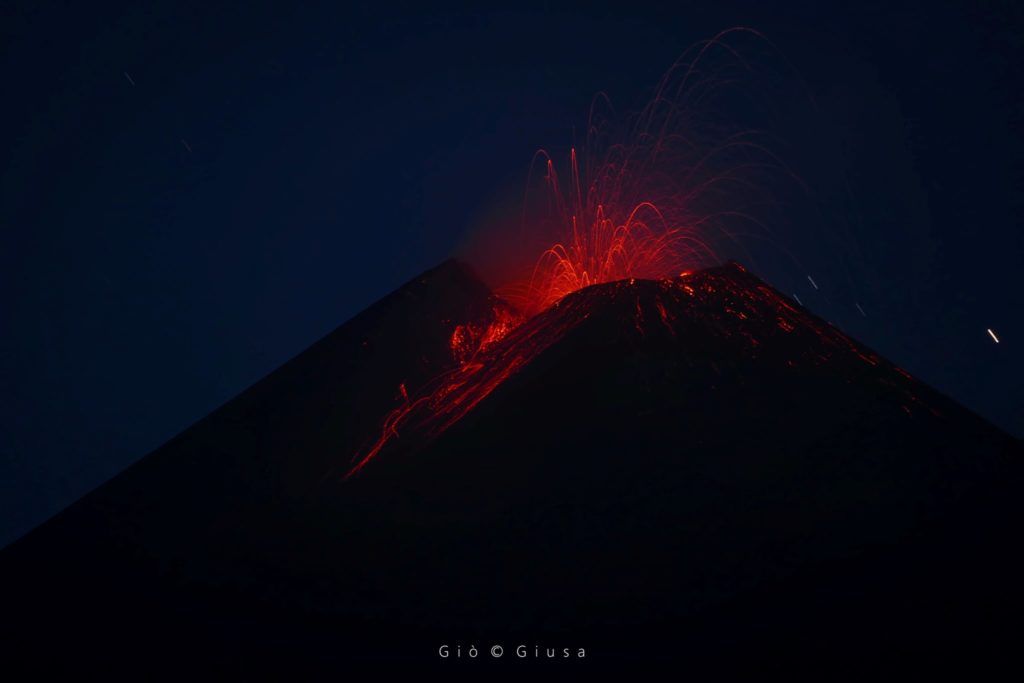
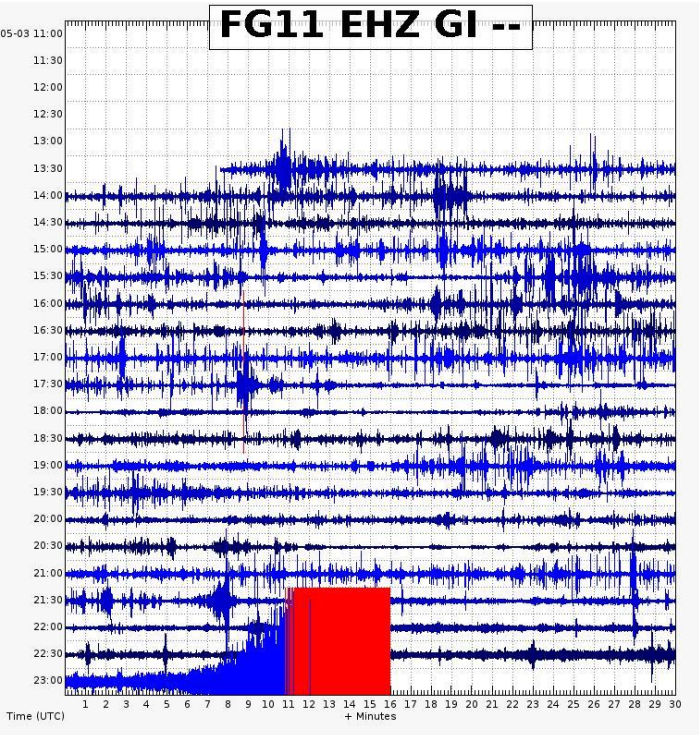
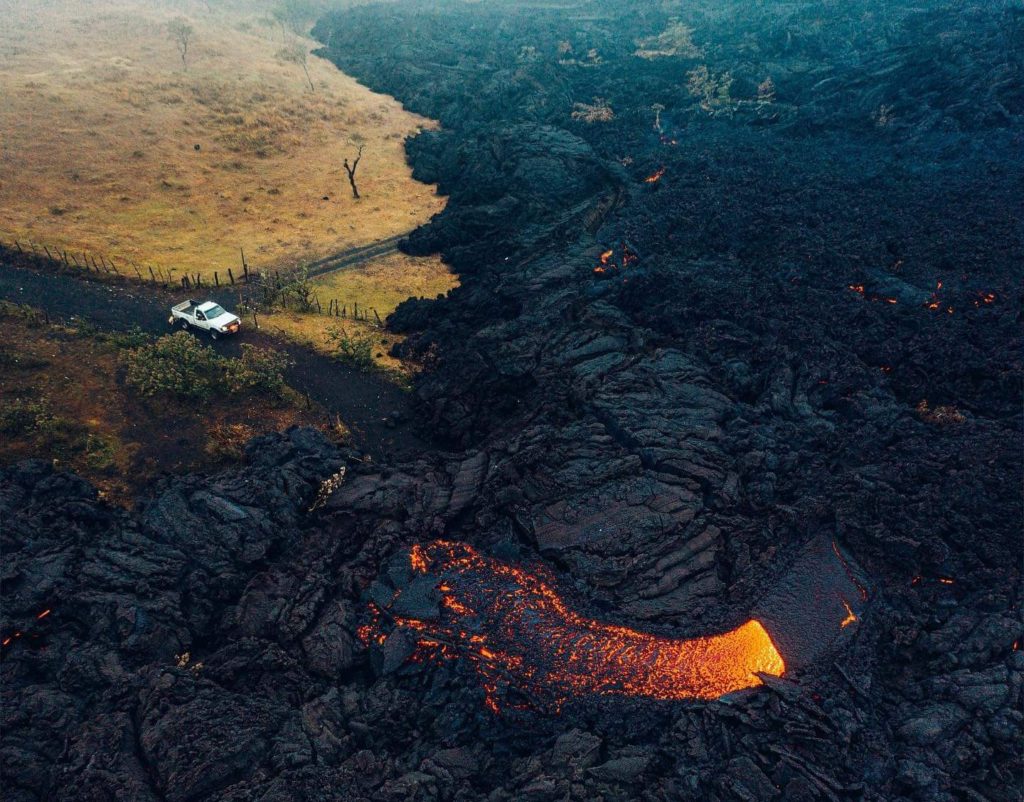
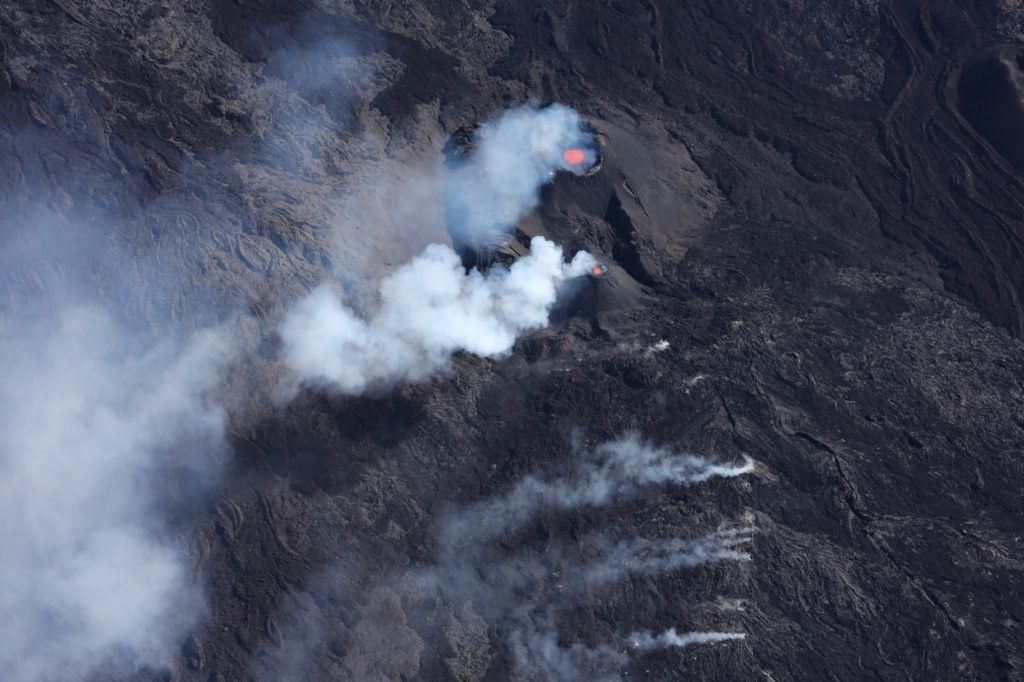

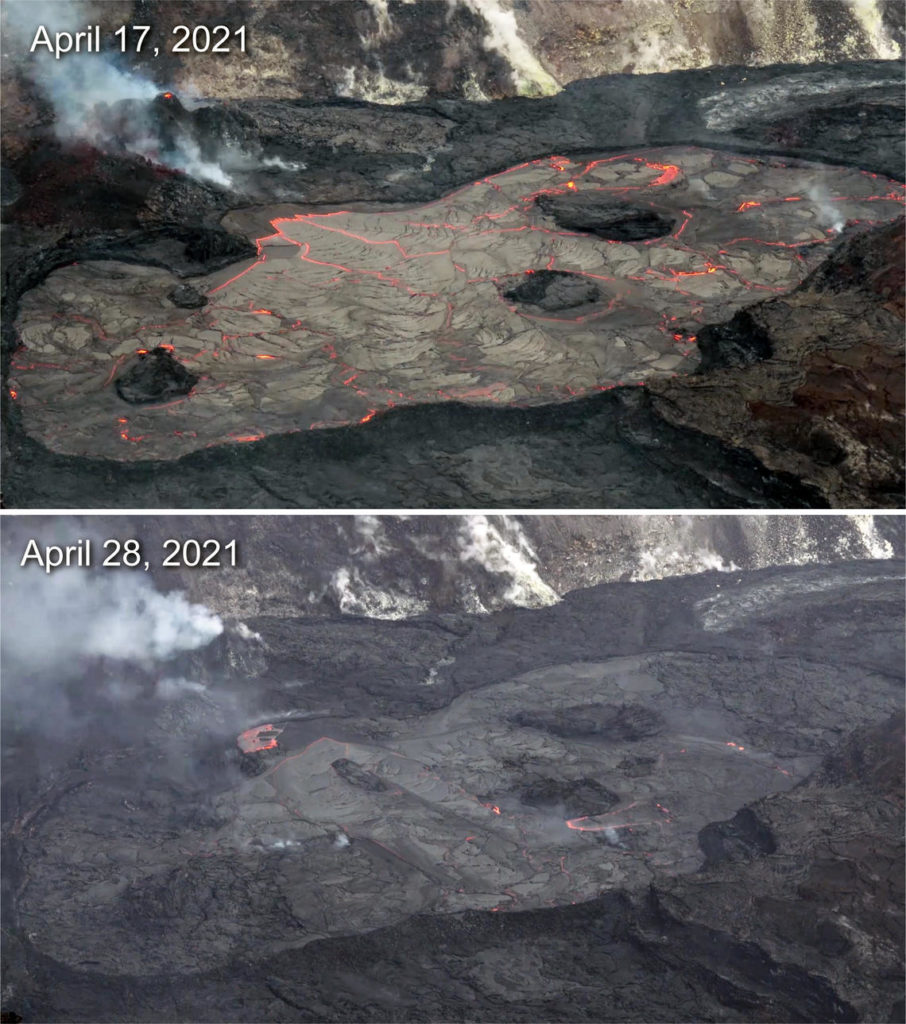
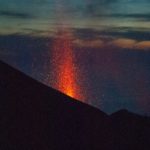



No comment yet, add your voice below!